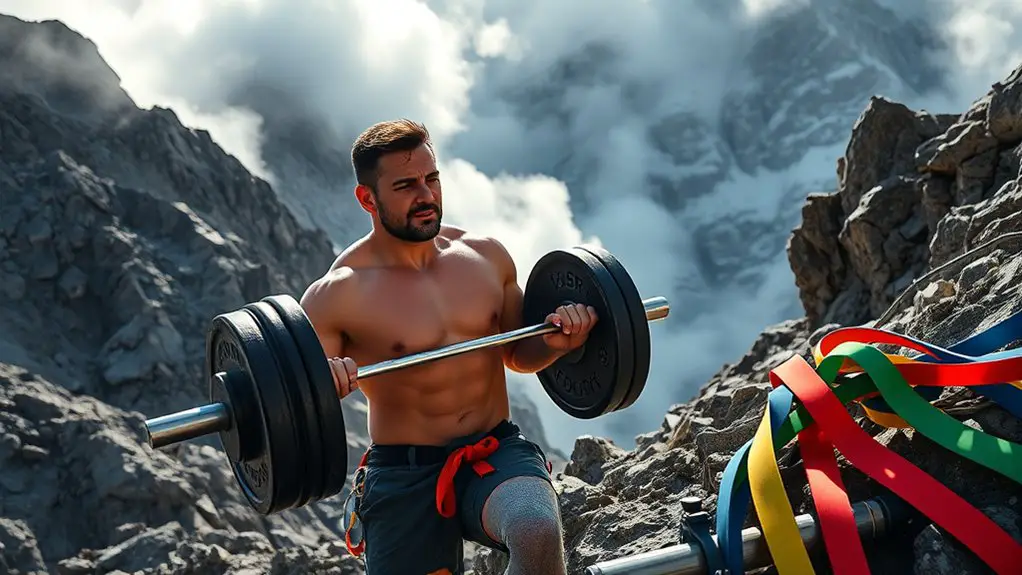The Best Strength Workouts for Mountaineering Training

For effective mountaineering training, focus on core strength, leg power, and upper body endurance. Incorporate exercises like planks and squats for stability and endurance. Don’t forget upper body workouts with pull-ups to enhance grip strength. Add functional movements that mimic climbing techniques, and plyometric drills for explosive power. Flexibility and mobility work is essential to prevent injuries. By mixing these workouts, you’ll build a solid foundation for tackling challenging terrains ahead. More insights await you to further elevate your training!
Building Core Strength for Stability on the Mountain

As you prepare for your next mountaineering adventure, remember that a strong core isn’t just a nice-to-have—it’s vital for maintaining stability and balance on unpredictable terrain. Core stability plays a pivotal role in how well you navigate rocky paths and steep inclines. Incorporating balance training into your routine will enhance your body’s ability to react to sudden shifts, preventing falls and injuries.
To build core strength, focus on exercises like planks, Russian twists, and stability ball workouts. These movements engage your abdominal muscles and improve overall posture, which is significant when carrying a heavy pack. Consider adding balance exercises, such as single-leg stands or yoga poses, to sharpen your proprioception.
Consistency is key—aim for a few sessions each week. You’ll notice the difference in your performance and confidence on the mountain, ensuring you tackle every challenge with strength and poise.
Leg Workouts for Endurance and Power
While you might think cardio is the only focus for endurance, leg workouts are essential for building the power and stamina needed to tackle demanding mountain trails. Incorporating squat variations and hill sprints into your routine will not only strengthen your legs but also improve your overall endurance.
Here’s a quick reference table for effective leg workouts:
| Workout Type | Key Focus | Suggested Sets/Reps |
|---|---|---|
| Squat Variations | Strength & Power | 3-4 sets of 8-12 reps |
| Hill Sprints | Speed & Endurance | 5-8 sprints, 30 sec each |
| Lunges | Balance & Stability | 3 sets of 10-15 reps |
Make these exercises a regular part of your training, and you’ll notice significant improvements in your climbing performance. Embrace the challenge, and your legs will thank you when you’re conquering those steep ascents!
Upper Body Strength for Climbing Efficiency

To maximize your climbing efficiency, building upper body strength is vital. Incorporating essential exercises will enhance your grip strength, while also improving your endurance and stability on the rock face. Focus on a balanced routine that targets these areas, and you’ll see significant gains in your performance.
Essential Upper Body Exercises
Building upper body strength is essential for enhancing your climbing efficiency, especially since your arms, shoulders, and back play pivotal roles in maneuvering and maintaining stability on challenging ascents. Incorporate pull up variations and push up progressions into your training regimen. These exercises not only build strength but also improve endurance, vital for long climbs.
| Exercise | Description |
|---|---|
| Pull Up Variations | Try wide grip, chin-ups, and commando pull-ups for diverse muscle engagement. |
| Push Up Progressions | Start with standard push-ups, then progress to incline and decline variations. |
| Dips | Great for targeting triceps, shoulders, and chest. |
Focus on mastering these techniques, and you’ll notice significant improvements in your climbing performance. Stay consistent, and push your limits!
Building Grip Strength
Upper body strength alone won’t propel you up a mountain; grip strength is equally essential for your climbing efficiency. To enhance your grip, incorporate grip training into your routine. Start with forearm exercises like wrist curls and reverse curls to build the muscles that support your grip. Use a hangboard to develop finger strength, allowing you to hold onto those challenging holds longer. Don’t forget to include farmer’s walks; they’ll improve your grip endurance while engaging your core and legs. Aim for at least two grip training sessions per week, progressively increasing the difficulty as you get stronger. Remember, a solid grip can make the difference between a successful climb and a frustrating fall. Keep pushing, and you’ll see results!
Improving Endurance and Stability
While climbing often emphasizes raw strength, improving endurance and stability in your upper body can greatly enhance your overall efficiency. Incorporating endurance techniques and stability drills into your training routine can make a noticeable difference. Here’s a quick overview of exercises to evaluate:
| Exercise | Focus Area | Duration/ Reps |
|---|---|---|
| Pull-Ups | Endurance | 3 sets of 8-10 |
| Plank to Push-Up | Stability | 3 sets of 10 |
| Weighted Dips | Strength & Endurance | 3 sets of 6-8 |
Functional Movements to Mimic Climbing Techniques

As you prepare for your mountaineering adventures, incorporating functional movements that mimic climbing techniques is essential for building strength and endurance. Focus on exercises that engage multiple muscle groups, improving your overall functional fitness. For instance, try pull-ups to replicate the pulling motion of climbing, enhancing your upper body strength. Use dynamic movements like lunges with a twist to simulate the foot placement and balance required on steep terrain.
Incorporating kettlebell swings can also develop hip explosiveness and core stability, critical for maintaining control while climbing. Don’t forget to integrate core exercises such as planks and mountain climbers, which are fundamental for maintaining body tension during ascents. Finally, consider using a climbing wall or bouldering to practice these functional training techniques in a real-world context. By focusing on these movements, you’ll better prepare your body for the challenges of mountaineering.
Plyometric Exercises for Explosive Power
To maximize your climbing performance, integrating plyometric exercises into your training regimen can greatly enhance your explosive power. These explosive movements are essential for quick and powerful ascents. Here are some effective jumping drills to incorporate:
- Box Jumps: Boost your vertical leap and leg strength.
- Broad Jumps: Improve your horizontal power for dynamic moves.
- Tuck Jumps: Enhance your core stability while maximizing height.
- Depth Jumps: Train your reactive strength and landing mechanics.
- Lateral Bounds: Develop agility and balance for varied terrains.
Resistance Training for Muscle Growth

Incorporating resistance training into your mountaineering regimen is essential for building the muscle strength necessary to tackle challenging ascents. Focus on compound movements like squats, deadlifts, and bench presses to engage multiple muscle groups, enhancing overall strength. Aim for 3-4 sets of 8-12 reps, adjusting the weight according to your capacity.
To maximize muscle growth, prioritize muscle recovery. This means allowing adequate rest between workouts and incorporating active recovery days. Don’t underestimate the power of nutrition strategies; fueling your body with protein-rich foods after training is vital for muscle repair. Consider a post-workout shake or a balanced meal to replenish lost nutrients. Additionally, understanding your daily protein needs can help you optimize your intake for muscle recovery.
Stay consistent and progressive in your resistance training, gradually increasing the weights to continually challenge your muscles. Remember, the stronger you are, the better you’ll perform when faced with the demands of mountaineering. Keep pushing your limits!
Flexibility and Mobility Work for Injury Prevention
While you’re building strength for mountaineering, don’t overlook the importance of flexibility and mobility work in preventing injuries. Incorporating these elements into your training routine can enhance your performance and reduce your risk of strains and sprains. Focus on dynamic stretching to improve your range of motion and prepare your body for the demands of climbing. Here are some key practices to include:
- Leg swings for hip mobility
- Arm circles to loosen shoulder joints
- Walking lunges to engage the entire lower body
- Torso twists for spinal flexibility
- Ankle circles to increase stability
Make these exercises a regular part of your warm-up and cool-down routine. By prioritizing flexibility and mobility, you’ll boost your overall efficiency and resilience on the mountain. Remember, injury prevention is just as essential as strength training in your preparation for high-altitude adventures!
Frequently Asked Questions
How Often Should I Train for Mountaineering Strength?
When it comes to training frequency for building strength, aim for at least three to four sessions per week. This consistency will help you achieve significant strength adaptations over time. Focus on compound movements that engage multiple muscle groups, as they’ll give you the most bang for your buck. Remember, rest days are just as important; they allow your muscles to recover and grow stronger. Stay committed, and you’ll see the results you’re after!
What Equipment Do I Need for Strength Workouts?
You don’t need a fancy gym to get ripped! A solid home gym can be your secret weapon. Grab some resistance bands; they’re like magic ropes that’ll turn you into a strength-training superhero! With just these bands, you can release an arsenal of exercises. Add a few dumbbells or a kettlebell, and you’ve got everything you need. Stay consistent, and you’ll be crushing your goals in no time. Let’s get to work!
Can I Improve Strength Without a Gym?
Absolutely, you can improve strength without a gym! Focus on bodyweight exercises like push-ups, squats, and lunges. These can be done anywhere, so consider outdoor workouts in parks or your backyard. Incorporate resistance bands or even find natural weights like rocks or logs to challenge yourself. Consistency is key, so set a routine. With dedication and creativity, you’ll build strength effectively, no gym required! Keep pushing your limits!
How Long Should Each Workout Session Last?
Ever tried to outrun a T-Rex? Well, you don’t need that kind of pressure! When it comes to workout duration, aim for 45 to 90 minutes per session. This gives you enough time to ramp up the intensity without burning out. Focus on quality over quantity; shorter, high-intensity workouts can be more effective than longer, less intense ones. Listen to your body, adjust as needed, and stay consistent for the best results!
What Nutrition Supports Strength Training for Mountaineering?
To support your strength training effectively, focus on nutritional timing and quality protein sources. Eating a balanced meal with protein within 30 minutes post-workout can maximize muscle recovery and growth. Incorporate lean meats, legumes, and dairy into your diet. Don’t forget about carbs; they’ll fuel your workouts and replenish glycogen stores. Stay hydrated, and consider healthy fats for overall energy. With the right nutrition, you’ll boost your performance and reach your mountaineering goals!





